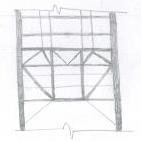-
Posts
475 -
Joined
-
Last visited
-
Days Won
242
Reputation Activity
-
 EngrUzair got a reaction from UmarMakhzumi in Lower compressive strength of concrete
EngrUzair got a reaction from UmarMakhzumi in Lower compressive strength of concrete
In general, this issue is controlled by relevant clause of contract agreement. Following are the possible options that may be or might have been specified in the contract:-
a. Demolition & recasting, in case actual strength falls MORE than a certain percent below the required concrete strength
b. Strength evaluation of actual structure, according to applicable design code & acceptability or rejection of structure accordingly.
c. Rarely, there might also be an option to strengthen the structure (using conventional or advanced strengthening techniques & materials) to the required level (where possible).
Regards.
-
 EngrUzair got a reaction from UmarMakhzumi in Solid slab
EngrUzair got a reaction from UmarMakhzumi in Solid slab
If you are asking about possibility of designing a single slab of given dimensions, theoretically it can be.
Practically however such a large slab will have undesirably high self-weight and deflection, if designed without beams.
Self-weight as well as deflection can be controlled by providing beams along outer edges & at suitable intervals parallel to short span of the slab for reducing required thickness of slab from deflection point of view.
Regards.
-
 EngrUzair got a reaction from ILYAS in Lower compressive strength of concrete
EngrUzair got a reaction from ILYAS in Lower compressive strength of concrete
In general, this issue is controlled by relevant clause of contract agreement. Following are the possible options that may be or might have been specified in the contract:-
a. Demolition & recasting, in case actual strength falls MORE than a certain percent below the required concrete strength
b. Strength evaluation of actual structure, according to applicable design code & acceptability or rejection of structure accordingly.
c. Rarely, there might also be an option to strengthen the structure (using conventional or advanced strengthening techniques & materials) to the required level (where possible).
Regards.
-
 EngrUzair got a reaction from abbaskhan2294 in Construction/Cold joint location in RC Column/walls
EngrUzair got a reaction from abbaskhan2294 in Construction/Cold joint location in RC Column/walls
Here are my two cents:-
1. General guidance regarding placement of construction joints in RC work has been provided in Section 6.4 of ACI 318-08 and its commentary. Some clarity is given in section 6.4.3, where it is stated that "Construction joints shall be so made and located as not to impair the strength of the structure. Provision shall be made for transfer of shear and other forces through construction joints."
For transfer of shear etc through construction joints, reference is made to the ACI Section 11.6.9 that deals with the calculation of shear-friction, at the interface between two concretes cast at different times (beside other situations described in section 11.6.1 of the code).
Moreover, Section 6.4.4 suggests that "Construction joints in floors shall be located within the middle third of spans of slabs, beams, and girders.
2. Regarding construction joints in columns, however, Section 6.4 does not provide guidance clearer than that in Section 6.4.6 stating that the "Beams, girders, or slabs supported by columns or walls shall not be cast or erected until concrete in the vertical support members is no longer plastic."
And, the commentary section R6.4.6 explains that "Delay in placing concrete in members supported by columns and walls is necessary to prevent cracking at the interface of the slab and supporting member caused by bleeding and settlement of plastic concrete in the supporting member."
3. The support member (referred in previous paragraph) will generally be a column or a wall. And, in a simplified form, Section 6.4.4 & its commentary are advising us NOT to cast beams & slab monolithically with the wall or column, BUT only after the supporting column (or wall) concrete has hardened, in order to avoid plastic cracking at the beam-column (or beam-wall) joint.
4. In our normal field practice (within Pakistan as well as abroad), beams & slabs are cast at least one day after casting of columns or supporting walls. This gap of one day (between casting of column & beam concretes) ensures that the column (or wall) concrete poured one day earlier has hardened (is no longer plastic), thereby avoiding any possibility of plastic cracking (discussed in paragraph 2 above).
5. Now coming to your queries;
In general terms, it is preferable to cast the column in one pour..
However, in compelling circumstances it may be done in more than one pour too, subject to certain conditions.
Already described in initial paragraphs.
This is the normal & IMHO desirable practice, according to ACI code Section 6.4.6.
IMO, leaving 9" or 12" column depth below the beam soffit is excessive & undesirable. It should not be more than 1" or 2" in any case.
IMO, this practice is based on the requirements of ACI 318-08 (also ACI 318-11) Section 6.4.6.
The same requirement is available in ACI 318-14 Section 26.5.7.2 (a) as well.
HTH
Regards.
-
 EngrUzair got a reaction from ANStructs in Construction/Cold joint location in RC Column/walls
EngrUzair got a reaction from ANStructs in Construction/Cold joint location in RC Column/walls
Here are my two cents:-
1. General guidance regarding placement of construction joints in RC work has been provided in Section 6.4 of ACI 318-08 and its commentary. Some clarity is given in section 6.4.3, where it is stated that "Construction joints shall be so made and located as not to impair the strength of the structure. Provision shall be made for transfer of shear and other forces through construction joints."
For transfer of shear etc through construction joints, reference is made to the ACI Section 11.6.9 that deals with the calculation of shear-friction, at the interface between two concretes cast at different times (beside other situations described in section 11.6.1 of the code).
Moreover, Section 6.4.4 suggests that "Construction joints in floors shall be located within the middle third of spans of slabs, beams, and girders.
2. Regarding construction joints in columns, however, Section 6.4 does not provide guidance clearer than that in Section 6.4.6 stating that the "Beams, girders, or slabs supported by columns or walls shall not be cast or erected until concrete in the vertical support members is no longer plastic."
And, the commentary section R6.4.6 explains that "Delay in placing concrete in members supported by columns and walls is necessary to prevent cracking at the interface of the slab and supporting member caused by bleeding and settlement of plastic concrete in the supporting member."
3. The support member (referred in previous paragraph) will generally be a column or a wall. And, in a simplified form, Section 6.4.4 & its commentary are advising us NOT to cast beams & slab monolithically with the wall or column, BUT only after the supporting column (or wall) concrete has hardened, in order to avoid plastic cracking at the beam-column (or beam-wall) joint.
4. In our normal field practice (within Pakistan as well as abroad), beams & slabs are cast at least one day after casting of columns or supporting walls. This gap of one day (between casting of column & beam concretes) ensures that the column (or wall) concrete poured one day earlier has hardened (is no longer plastic), thereby avoiding any possibility of plastic cracking (discussed in paragraph 2 above).
5. Now coming to your queries;
In general terms, it is preferable to cast the column in one pour..
However, in compelling circumstances it may be done in more than one pour too, subject to certain conditions.
Already described in initial paragraphs.
This is the normal & IMHO desirable practice, according to ACI code Section 6.4.6.
IMO, leaving 9" or 12" column depth below the beam soffit is excessive & undesirable. It should not be more than 1" or 2" in any case.
IMO, this practice is based on the requirements of ACI 318-08 (also ACI 318-11) Section 6.4.6.
The same requirement is available in ACI 318-14 Section 26.5.7.2 (a) as well.
HTH
Regards.
-
 EngrUzair got a reaction from ILYAS in ACI 318 clause for beam and column definition
EngrUzair got a reaction from ILYAS in ACI 318 clause for beam and column definition
Yes.
ILYAS is right.
Definitions of beam & column are also given in Section 2.3 of ACI 318-14.
In earlier versions of the ACI 318 (2005, 2008, 2011 etc ) definition of column was also given in Chapter 2. However, definition of beam was not included till then. Rather it was referred as a flexural member.
AFAIK definition of "beam" was most probably included for the first time in 2014 version of ACI 318, after it was included in ACI Concrete Terminology 2013.
Regards.
-
 EngrUzair got a reaction from UmarMakhzumi in ACI 318 clause for beam and column definition
EngrUzair got a reaction from UmarMakhzumi in ACI 318 clause for beam and column definition
Yes.
ILYAS is right.
Definitions of beam & column are also given in Section 2.3 of ACI 318-14.
In earlier versions of the ACI 318 (2005, 2008, 2011 etc ) definition of column was also given in Chapter 2. However, definition of beam was not included till then. Rather it was referred as a flexural member.
AFAIK definition of "beam" was most probably included for the first time in 2014 version of ACI 318, after it was included in ACI Concrete Terminology 2013.
Regards.
-
 EngrUzair reacted to ILYAS in ACI 318 clause for beam and column definition
EngrUzair reacted to ILYAS in ACI 318 clause for beam and column definition
BEAM AND COLUMN ARE DEFINE IN START OF ACI 318-14,NOT IN ANY CLAUSE
-
 EngrUzair got a reaction from Waqar Saleem in fresh engineer but dont know about the field
EngrUzair got a reaction from Waqar Saleem in fresh engineer but dont know about the field
Dear Shafqat,
AA. Field work of a civil engineer generally consists of following activities:
a. Surveying / levelling of the project area
b. Supervision of construction work for buildings, roads, culverts, bridges etc., in accordance with detailed working drawings, applicable material specifications and quality standards.
c. Preparation of material estimates, by calculating quantities of different items of work (e.g., excavation, concrete, brickwork, plaster, reinforcing steel etc-in case of buildings, and subbase, base, wearing course etc, in case of roadwork) included in working drawings of the project.
2. To perform all these tasks in better & efficient way, you will need to review your class notes & text books of relevant subjects (Surveying, Civil Engineering Practice, Estimating & Costing, Highways & Roads, Engineering Materials) taught during your civil engineering studies, in order to understand theoretical & practical aspects of these subjects.
3. As regards, which subject you should review first, would depend upon the work you are asked /assigned to do by your senior engineer. As a Trainee Engineer, you will certainly be attached with a senior engineer, who will assign you different engineering tasks & check your work. You may & must obtain his advice in all the work matters, where you are in doubt, or unclear about how to perform a given task.
4. In case you have futher querries, please do ask, by narrating your problem in detail. I will be happy to help you, as far as I can.
By the way, what kind of civil works are carried out by your company mostly? Building work, roadwork or both?
Regards.
-
 EngrUzair got a reaction from UmarMakhzumi in ACI 318 clause for beam and column definition
EngrUzair got a reaction from UmarMakhzumi in ACI 318 clause for beam and column definition
According to ACI Concrete Terminology 2013,
a "beam" is defined as " a structural member subjected primarily to flexure but may also be subjected to axial load."
Whereas, a "column" is a "member with a ratio of height-to-least-lateral-dimension exceeding 3 used primarily to support axial compressive load."
Design of a structural member (as a beam or column) in ACI 318 code is based on above-mentioned definitions.
Regards.
-
 EngrUzair got a reaction from Badar (BAZ) in High Strength Rebar With Low Strength Concrete
EngrUzair got a reaction from Badar (BAZ) in High Strength Rebar With Low Strength Concrete
Following are a few disadvantages of using higher strength rebars with a lower strength concrete:
1. Larger tension (as well as compression) development & lap-splice lengths will be required.
2. Overall load carrying capacity of a compression member will be lesser, compared with when higher strength concrete is used.
3. Maximum amount of steel reinforcement, that can be used in a flexural member, will also be lesser, thereby reducing its overall load carrying capacity.
4. Member size & self-weight will be somewhat larger, when steel yield strength is more than 60,000 psi.
Regards.
-
 EngrUzair got a reaction from Waqar Saleem in Screen Time
EngrUzair got a reaction from Waqar Saleem in Screen Time
I agree with waqar.
IMO, childern must be motivated towards & provided opportunities to play different health improving outdoor games (football, cricket, badminton, etc) , instead of watching TV or playing games on computer.
My chidren are school going, and whenever they have done their homework, and it is pleasant outside (especially after Asr prayer), I send them out in a nearby park area. There they can play football or cricket, and can do exercise as well.
On weekends, during vacations and on other days when they are unable to go outside, they generally watch tv for 1-2 hours.
-
 EngrUzair got a reaction from UmarMakhzumi in Screen Time
EngrUzair got a reaction from UmarMakhzumi in Screen Time
I agree with waqar.
IMO, childern must be motivated towards & provided opportunities to play different health improving outdoor games (football, cricket, badminton, etc) , instead of watching TV or playing games on computer.
My chidren are school going, and whenever they have done their homework, and it is pleasant outside (especially after Asr prayer), I send them out in a nearby park area. There they can play football or cricket, and can do exercise as well.
On weekends, during vacations and on other days when they are unable to go outside, they generally watch tv for 1-2 hours.
-
 EngrUzair got a reaction from Ali Sufyan in R value for Minaret structure..
EngrUzair got a reaction from Ali Sufyan in R value for Minaret structure..
IMO, if the lift core consists of RC walls and columns are part of a frame system, it may possibly be considered a Dual System consisting of RC shear walls with IMRF (R=6.5) or simply IMRF ( R=5.5).
Otherwise, the minaret might be considered to correspond to "Distributed mass cantilever structures such as stacks, chimneys, silos and skirt-supported vertical vessels" (S/No. 3 in UBC-97 Table 16-P), for which R=2.9.
HTH
Regards.
-
 EngrUzair got a reaction from Ayesha in R value for Minaret structure..
EngrUzair got a reaction from Ayesha in R value for Minaret structure..
IMO, if the lift core consists of RC walls and columns are part of a frame system, it may possibly be considered a Dual System consisting of RC shear walls with IMRF (R=6.5) or simply IMRF ( R=5.5).
Otherwise, the minaret might be considered to correspond to "Distributed mass cantilever structures such as stacks, chimneys, silos and skirt-supported vertical vessels" (S/No. 3 in UBC-97 Table 16-P), for which R=2.9.
HTH
Regards.
-
 EngrUzair got a reaction from Waqar Saleem in Washigton Accord !!!
EngrUzair got a reaction from Waqar Saleem in Washigton Accord !!!
Dear Waqar,
AFAIK, main benefit will be in the form of opportunity to practice engineering (work as an engineering professional) within other Signatory i.e full member countries of the Accord, as the engineering qualifications of Pakistani Engineers will be acceptable to them now. Other requirements of Licensing Authorities of these countries, as and where applicable, would also need to be fulfilled.
Further details about Washington Accord, including list of Signatories & FAQs, may be checked at the following link:
http://www.abet.org/global-presence/mutual-recognition-agreements/engineering-washington-accord/
Regards.
-
 EngrUzair reacted to UmarMakhzumi in Washigton Accord !!!
EngrUzair reacted to UmarMakhzumi in Washigton Accord !!!
@EngrUzair has explained it very nicely. I will just add two things:
First that the only benefit would be to student graduating after the date the accord has been signed. So existing graduates aren't getting any benefit. Also there are specific Pakistani universities that are being recognized under the accord. This further narrow downs the list of potential beneficiaries.
The second thing like Uzair Sb mentioned is the benefit of education accreditation. A professional engineer registered with PEC and working in Pakistan who wishes to practice engineering abroad would still need to go through the complete application process (Washington Accord doesn't remove that requirement) but the only benefit he/ she would have is that the education verification would be skipped provided he graduated after the ratification of Washington Accord from one of the universities recognized under the accord at that time .
Thanks.
-
 EngrUzair got a reaction from UmarMakhzumi in Washigton Accord !!!
EngrUzair got a reaction from UmarMakhzumi in Washigton Accord !!!
Dear Waqar,
AFAIK, main benefit will be in the form of opportunity to practice engineering (work as an engineering professional) within other Signatory i.e full member countries of the Accord, as the engineering qualifications of Pakistani Engineers will be acceptable to them now. Other requirements of Licensing Authorities of these countries, as and where applicable, would also need to be fulfilled.
Further details about Washington Accord, including list of Signatories & FAQs, may be checked at the following link:
http://www.abet.org/global-presence/mutual-recognition-agreements/engineering-washington-accord/
Regards.
-
 EngrUzair got a reaction from Ayesha in Use Of Mass Source Command In Etabs
EngrUzair got a reaction from Ayesha in Use Of Mass Source Command In Etabs
No, in case the inclusion of live load in Mass Source is not required as per your applicable design code, and other parameters including 'Additional masses' have been correctly applied. Otherwise, yes.
Replies to your other questions and doubts are available at the following link:
http://docs.csiamerica.com/help-files/etabs/Menus/Define/Mass_Source.htm
Regards.
-
 EngrUzair got a reaction from UmarMakhzumi in High Loads under Columns and Bearing Capacity Failure
EngrUzair got a reaction from UmarMakhzumi in High Loads under Columns and Bearing Capacity Failure
AFAIK, assigning springs to beams is not required.
In additon to what Ayesha has suggested, it might be better to check back from your current (and if possible, also from some other) geotechnical investigator about the usable bearing capacity for raft foundation, because 0.5 TSF bearing capacity appears to be very low value for a sandy soil. IMO, it should be more. So, better get it reviewed.
Moreover, increasing the number of columns will not reduce overall load or required area of raft. However, if possible, it might reduce required raft thickness due to punching shear.
You may reduce overall raft loading by reducing thickness of raft itself, in the areas where column punching does not affect. This may be done by providing thicker raft in column strips, or in even in the form of thicker pads under the columns only, provided other structural requirements are satisfied.
Regards.
-
 EngrUzair reacted to Waqas Haider in Venice, The floating City
EngrUzair reacted to Waqas Haider in Venice, The floating City
From engineering point of view, it is really very amazing to see a complete city builtup in water ways, in a lagoon. How did they make the foundation system of buildings completely all the time underwater? Really interesting article here is. It also explains some modern challanges to the city i.e. flooding due to raised levels of sea and an inteseting solution to this problem.
https://sites.google.com/site/engineeringvenice/
-
 EngrUzair got a reaction from Fatima Khalid in Expert opinion on M.Sc. research Topic selection
EngrUzair got a reaction from Fatima Khalid in Expert opinion on M.Sc. research Topic selection
WA.
Dear Junaid,
1. Your research topic is very important, being directly related to the professional engineering practice. Please do share the results & conclusions here, on completion of your research, for the benefit of forum users.
2. For obtaining relevant literature, you may adopt following methods:
a. Your university will certainly be having subscription to one or more research publishing websites (like ScienceDirect etc). If so, you may search & download relevant research material from these websites.
b. You may also request your colleagues studying in other universities to do a similar search on the websites subscribed by their institutions, in case their subscribed research sites are different.
c. Use Google search (with pdf option) to find out relevant research material from many other resources (international universities, research sharing sites like Research Gate & more), downloadable free of cost in several cases.
Wish you best of luck in your research.
Regards.
-
 EngrUzair got a reaction from UmarMakhzumi in Expert opinion on M.Sc. research Topic selection
EngrUzair got a reaction from UmarMakhzumi in Expert opinion on M.Sc. research Topic selection
WA.
Dear Junaid,
1. Your research topic is very important, being directly related to the professional engineering practice. Please do share the results & conclusions here, on completion of your research, for the benefit of forum users.
2. For obtaining relevant literature, you may adopt following methods:
a. Your university will certainly be having subscription to one or more research publishing websites (like ScienceDirect etc). If so, you may search & download relevant research material from these websites.
b. You may also request your colleagues studying in other universities to do a similar search on the websites subscribed by their institutions, in case their subscribed research sites are different.
c. Use Google search (with pdf option) to find out relevant research material from many other resources (international universities, research sharing sites like Research Gate & more), downloadable free of cost in several cases.
Wish you best of luck in your research.
Regards.
-
 EngrUzair reacted to EngrJunaid in Expert opinion on M.Sc. research Topic selection
EngrUzair reacted to EngrJunaid in Expert opinion on M.Sc. research Topic selection
In order to study the effect/performance of infill walls we are providing infill walls in our half scaled 2-story RC Frame model which we will be testing on 6DOF Shake Table here in Earthquake Engineering Center, UET Peshawar...
-
 EngrUzair got a reaction from Ayesha in Reinforcement in Sap 2000
EngrUzair got a reaction from Ayesha in Reinforcement in Sap 2000
Your question is not clear. If you explain your problem in a bit detail, you may get a more specific reply. However, if the purpose of your question is to know about general procedure of interpreting reinforcements given by SAP2000 software, it is given below.
1. When we design a concrete frame in SAP2000, it gives following different types of reinforcement:
a. In case of columns, required areas of main (or vertical) steel bars and lateral (or ties) reinforcement.
b.In case of beams, results are in the form of reinforcement areas for bottom & top main bars as well as stirrups.
2. Given area of steel for column vertical bars is to be converted to suitable number of bars (using theoretical bar areas, as we do for manual calculations) according to code requirements in such a way that the provided steel area is either equal to or a bit more than the area required by SAP2000. Similarly, reinforcement areas given for bottom & top bars of beam members are converted to suitable number & sizes of bars, such that provided steel area is either equal to or a bit more than the area required by the software.
3. Reinforcement areas provided by SAP2000 for column ties & beam stirrups can be converted to suitable tie & stirrup size and spacing, similar to that explained in the following thread for ETABS case:
HTH
Regards.









